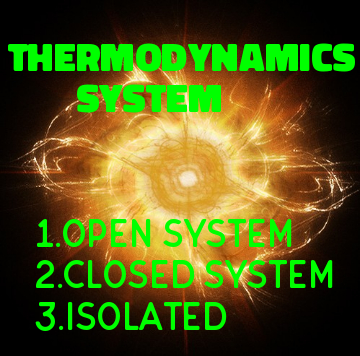THERMODYNAMICS SYSTEM AND LAW OF THERMODYNAMICS
INTRODUCTION
The Thermodynamics is that branch of Engineering - science which deals with the energies possessed by gases and vapors. It also includes the conversion of these energies in terms of heat mechanical work and their relationship with properties of the system.
THERMODYNAMIC SYSTEM
The thermodynamic system may be defined as a definite area or a space where some thermodynamic process takes place. It may be noted that a thermodynamic system has its boundaries, and anything outside the boundaries is called its surroundings.
The thermodynamic bound may be classified into the following three groups ;
1. CLOSED SYSTEM: This is a system of fixed mass whose boundaries are determined by the space of the working substance occupied in it. In a closed system, heat and work cross the boundary of the system, but there is no addition or loss of the original mass of the working substance. Thus the ntss of the working substance.Thus the mass of the working substance which comprises the system, is fixed.
2. OPEN SYSTEM: In this system, the working substance crosses the boundary of the system. The heat and work may also cross the boundary.
3. ISOLATED SYSTEM: It is a system of fixed mass and no heat or work cross its boundary.
PROPERTIES OF A SYSTEM
The state of a system may be identified by certain observable quantities such as volume, temperature, pressure and density etc. All the quantities which identify the state of a system are called properties. The thermodynamic properties are divided into the following two classes,
(i). Extensive properties: The properties of the system, whose value for the entire system is equal to the sum of their values for the individual parts of the system, are called extensive properties.
Example, total volume, total mass and total energy of a system are extensive properties.
(ii). Intensive properties: The properties of the system, whose value for the entire system is not equal to the sum of their values for the individual parts of the system, are called, intensive properties.
Example, temperature, pressure and density of a system are intensive properties.
THERMAL EQUILIBRIUM:
When there are variations in temperature from point to point of an isolated system, the temperature at every point first changes with time. This rate of change decreases and eventually stops. When no further changes are observed, the system is said to be in thermal equilibrium.
LAWS OF THERMODYNAMICS
Following are the three laws of thermodynamics...
(i). Zeroth Law of Thermodynamics :- This Law states that when two bodies are in thermal equilibrium with a third body, they are also in thermal equilibrium with each other.
(ii). First Law of Thermodynamics :- This Law state that the heat and mechanical work are mutually convertible.According to this law, a define amount of mechanical work is needed to produce a definite of heat and vice versa.
This Law also state that the energy can neither be created nor destroyed, through it can be transformed from one form to another.According to this law,the energy due to heat supplied (Q) must be balanced by the external work done (W) plus the gain in internal energy (E) due to rise in temperature.
Q = W + E
(iii). Second Law of Thermodynamics :- This Law states that there is a define limit to the amount of mechanical energy, which can be obtained from a given quantity of heat energy.
(a). Claussius:
According to Claussius,this law may be stated as " It is impossible for self - acting machine working in a cyclic process, to transfer heat from a body at a lower tempreture to a body at a higher temperature without the aid of an external agency.
(b). Kelvin planks:
The second law of thermodynamics has also been stated by Kelvin-Planks as "It is impossible to construct an engine working on a cyclic process, whose sole purpose is to convert heat energy in to work." According to this statement,the second law of thermodynamics is sometimes called as law of degradation of energy.
Writer - sk najmul ( munna )



0 comments:
Post a Comment
Please do not enter any spam link in the comment box.